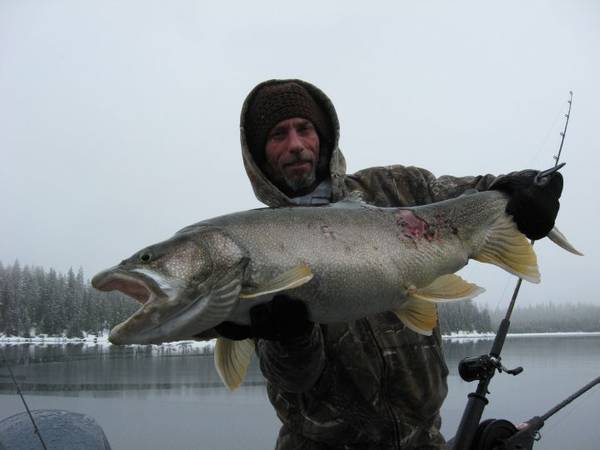|
Catching
fish at depths greater than 50 feet can sometimes cause a swelling of the airbladder as the fish is brought to the surface. This occurs most often with
rockfish off the coast but also is sometimes common when fishing for mackinaw. I usually fish at depths from 50-170 feet. This condition is
known as baratrauma and divers are familiar with this condition also known as "the bends." http://en.wikipedia.org/wiki/Barotrauma
I first experienced this while
fishing for mackinaw with long time guide Mickey Daniels at Lake Tahoe in the late 80's. The fish would come up with a swollen air bladder and could
not swim back down. Mickey's
solution was to insert the tip of a hypodermic needle in the fishes belly to release the air pressure and then he would release them and they could
swim back down. He called it "fizzing" and I adopted this method when I fished Tahoe and when I moved
to Oregon in '95.
I began to read more about this
on a California fishing forum and some of the guys talked about catching some of Mickey's released fish (he also tagged many
of his released fish over a 20 year period, then gave all the data to UNR's biology dept.) and described gangrene and other
nasty things from the partially healed fizzing scars. No doubt many of these fish did not survive. Today this method is known as venting and it is described as
the less desirable method compared to recompressing.
Recompressing
involves bringing the fish back down to the depth at which it was caught to allow those gasses to equalize and allowing the
fish to swim off and hopefully survive.
The dangers of venting are pretty obvious as it involves puncturing the belly randomly and causing a whole host of contamination
and bacterial issues as well as possibly puncturing a vital organ. The Shelton company as well as as a few others have developed
products to recompress fish.
Some
of the guys on that California fishing forum described using the downrigger clip and downrigger itself to bring the fish back down, but I could never get the fish
to keep from slipping off. I decided to make a device to successfully recompress the macks that I brought up with
a swollen airbladder. I rigged a heavy duty coat hanger with a small (4-6lb) spare downrigger ball on one
end and a sharpened tip on the other end. When I get a bloated mack that can't swim back down on
its own, I place this device on the downrigger in place of the regular ball. The sharpened tip goes thru the skin of the lower mouth of the the fishes
lower jaw and down he goes. The main point that I learned was that the sharpened end must be
at least 16" long so the fish cannot turn sideways and slip off.
| Here's a photo of Joe's Decompression Device |

|
Once
I made that sharpened end long enough this crude looking device has been 100% successful for getting bloated macks back down
to the bottom. I
have talked with other mack fishermen over the years and there is a consensus that fish brought up from 75-200 feet slowly
stand a better chance of not coming up bloated than if they are brought up too quickly.
Sometimes if the water
is calm you can look for air bubbles which means the fish is burping out that air.
Thats a good sign. Sometimes
guys will pause when the fish is about 30 feet down and wait briefly for those air bubbles.
A father/son mack team that I have known for years have another
method that they call "shocking." They simply throw the bloated fish into the water head first like a torpedo and the
abruptness of this seems to scare the air out of them. They claim it works.
I
have evidence that an eagle used this method on a fish that a friend of mine caught on my boat a couple years ago.
| Eagle Scarred Laker that perhaps was "shocked" |

|
If you look at the scars (there were equal scars on both sides) you can see a patch of skin
torn away and what appears to be claw marks behind it. The wound had healed over and the fish was obviously healthy enough
to try to eat another piece of plastic with hooks in it. I posted this on a fishing website and also sent the picture to 2
ODFW biologists. All seemed to concur that the scar was not from any disease or prop scars. My
best guess is that someone else had caught the fish maybe a month or so earlier. It was bloated and could
not swim back down. Either the fisherman did not see the fish come back up or he left it on the surface
not knowing what to do. As it lay on the surface flailing, an eagle likely tried to fly off with it. This
fish weighed 20lbs and no eagle was going to fly away with it, but the "shock" from being partially lifted out of the water
by the eagle was enough to "shock" the air out of its bladder and swim back down. I have no proof, but thats
our best guess. Whatever device or method you choose, please have a method ready to deploy if you bring
up a bloated fish.
Remember that as stewards of our resource of trophy trout "when we know better we are compelled
to act better."
Tight lines everyone,
Joe Moritz (aka Fish-on-Bend)
|

